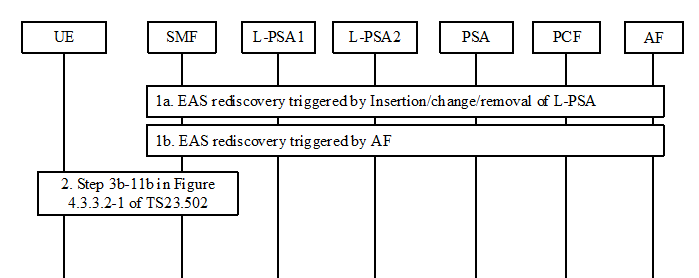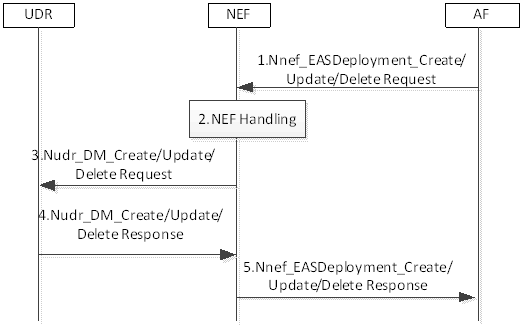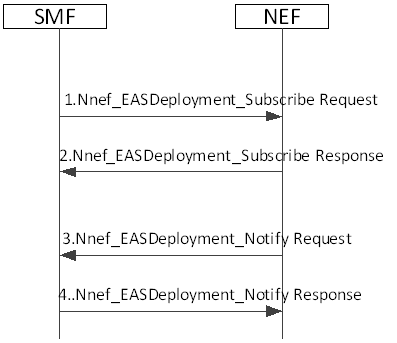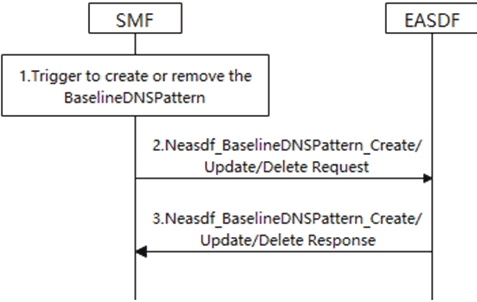Content for TS 23.548 Word version: 19.1.0
1…
4…
4.3
5…
6…
6.2.2.3…
6.2.3…
6.2.3.2.3…
6.2.3.2.5…
6.2.3.3…
6.3…
6.4…
6.5…
6.6
6.7…
6.7.2.4…
6.7.2.6…
6.7.3…
6.8…
6.10…
7…
A
B…
F…
6.2.3.3 EAS Re-discovery Procedure at Edge Relocation
6.2.3.4 EAS Deployment Information Management
6.2.3.4.1 General
6.2.3.4.2 EAS Deployment Information Provision from AF via NEF
6.2.3.4.3 EAS Deployment Information Management in the SMF or I-SMF
6.2.3.4.4 BaselineDNSPattern Management in the EASDF
6.2.4 EDC Functionality based DNS Query to reach EASDF/DNS Resolver/DNS Server indicated by the SMF
...
...
6.2.3.3 EAS Re-discovery Procedure at Edge Relocation p. 33
The support for EAS rediscovery indication procedure enables the UE to refresh stale EAS information stored locally so that the UE can trigger EAS discovery procedure to discover new EAS information.
For PDU Session with Session Breakout connectivity, the UE may indicate its support for refreshing stale EAS information to the SMF during the PDU Session Establishment procedure or, when the UE moves from EPS to 5GS for the first time, by using the PDU Session Modification procedure. If the UE indicates such support, the SMF may send to the UE the EAS rediscovery indication, with an optional impact field, so that the UE may trigger to re-discover the EAS (see the step 2 of Figure 6.2.3.3-1) after the insertion/change/removal of an L-PSA based on AF influence or its local configuration using the PDU Session Modification procedure, or based on the AF triggered EAS relocation.
This procedure is used by the SMF to trigger the EAS rediscovery procedure when a new connection to EAS need to be established. It applies to both Session Breakout using ULCL and Session Breakout using BP.

During a previous EAS Discovery procedure on this PDU Session the UE may have EAS information (i.e. EAS IP address corresponding to an EAS FQDN) locally stored, e.g. acquired during the previous connection with the EAS (for more information see Annex C UE considerations for EAS (re)discovery).
Step 1a.
Due to the UE mobility the SMF triggers L-PSA insertion, change or removal for the PDU Session. The insertion, change or removal of L-PSA triggers EAS rediscovery.
The L-PSA insertion, change or removal for the PDU Session may be triggered due to update of a common DNAI.
Step 1b.
The AF triggers EAS relocation e.g. due to EAS load balance or maintenance, etc. and informs the SMF the related information indicating the EAS relocation, as described in clause 4.3.6 AF influence on traffic routing procedure in TS 23.502.
AF may request to add/remove a UE to/from a set of UEs via AF influence on traffic routing procedure in TS 23.502. The PCF updates PCC rule to SMF (i.e. adding/removal of EAS Correlation indication/indication of traffic correlation and Traffic Correlation ID to/from the PCC rule). With the update of the PCC rule, the SMF detects that the UE is belonging to a set of UE(s) for a common EAS/DNAI, or the UE is not belonging to a set of UEs for common EAS/DNAI any longer and the common EAS/DNAI is not optimized for the UE, it may trigger EAS rediscovery.
If UE is belonging to a set of UE(s) for a common EAS/DNAI as instructed by the PCC rule, the SMF interacts with NEF for common EAS/DNAI selection as described in clauses 6.2.3.2.5 and 6.2.3.2.6.
Step 2.
This step may be performed as part of step 1a/1b. The SMF performs the network requested PDU Session Modification procedure from the step 3b-11b as defined in clause 4.3.3.2 of TS 23.502.
If the UE has indicated that it supports to refresh EAS information stored locally corresponding to the impact field per the EAS rediscovery indication from network, the SMF may send the impact field with the EAS rediscovery indication. SMF determines the impacted EAS(s) which need be rediscovered as the following:
- If an L-PSA is inserted/relocated/removed, the SMF determines the impact field, which is associated with the L-DN to be inserted, relocated or removed and identified by FQDN(s) or IP address range(s) of the old EAS, based on the association between FQDN(s)/IP address range(s) and DNAI provided by AF or SMF local configuration on the L-DN.
- For AF triggered EAS rediscovery, the AF may indicate the EAS rediscovery for the impacted applications, which are identified by Application Identifier(s), to the SMF via the AF influence on traffic routing procedure.
-
For EAS rediscovery triggered by UE mobility, the insertion/change/removal of L-PSA, which is related to the local traffic to EAS, is triggered by I-SMF. The I-SMF sends EAS rediscovery indication and optionally impact field to the SMF by invoking Nsmf_
PDUSession_ Request service operation. The SMF sends PDU Session Modification Command to UE as described above.Update
6.2.3.4 EAS Deployment Information Management p. 35
6.2.3.4.1 General p. 35
EAS Deployment Information management refers to the capability to create, update or remove EAS Deployment Information from AF and the distribution to the SMF or to the I-SMF in case I-SMF based Local Offloading Management applies. The NEF is in charge of the management of EAS Deployment Information which may be stored in UDR.
The EAS Deployment Information indicates how edge services are deployed in each Local part of the DN, the description of EAS Deployment Information is shown in Table 6.2.3.4-1.
| Parameters | Description |
|---|---|
| AF ID | Addressing information of Application Function responsible for the DNAI in the record. [optional]. See NOTE 1. |
| DNN | DNN for the EAS Deployment Information. [optional] |
| S-NSSAI | S-NSSAI for the EAS Deployment Information. [optional] |
| External Group Identifier/Internal Group Identifier | Group ID for the EAS Deployment information. [optional]. See NOTE 2. |
| Application ID | Identifies the application for which the EAS Deployment Information corresponds to. [optional] |
| FQDN(s) | Supported FQDN(s) for application(s) deployed in the Local part of the DN. |
| DNAI(s) | DNAI(s) for the EAS Deployment information. [optional] |
| DNS Server Information | list of DNS server identifier (consisting of IP address and port) for each DNAI. [optional] |
| EAS IP address range Information | IP address(es) of the EASs in the Local part of the DN or the IP address ranges (IPv4 subnetwork(s) and/or IPv6 prefix(es) of the Local part of the DN where the EAS is deployed for each DNAI. [optional] |
| N6 traffic routing information | Information about how to forward edge traffic in the local part of DN corresponding to DNAI. [optional] |
| N6 delay measurement assistance information | Includes the following parameters per DNAI and/or per EAS to enable N6 delay monitoring:
|
|
NOTE 1:
When an AF ID is provided, all DNAI(s) correspond to the same EHE provider.
NOTE 2:
The AF may provide External Group Identifier, and NEF can map the External Group Identifier into Internal Group Identifier according to information received from UDM. For HR-SBO roaming scenario, External Group Identifier and Internal Group Identifier, cannot be used by AF in VPLMN.
NOTE 3:
AF ID can be used in case of AF(s) involving different EHE providers, and the source EHE is unaware of other/target EHE specific deployment details.
NOTE 4:
A measurement endpoint can be used for delay measurements representing a single EAS IP address or a range (IPv4 subnet or IPv6 prefix) of EAS IP addresses.
NOTE 5:
The N6 delay measurement assistance information is utilized when AF traffic influence request includes indication of considering N6 delay as defined in clause 5.6.7.1 of TS 23.501.
NOTE 6:
Some examples of the measurement protocol(s) considered for N6 delay measurements are listed in clause 5.8.2.23 of TS 23.501.
|
|
The EAS Deployment Information management procedures are described in this clause, the procedures are independent of any PDU Session, including:
- The procedure for EAS Deployment Information management from AF via the NEF.
- The procedure for EAS Deployment Information management in the SMF or in the I-SMF when I-SMF based Local Offloading Management applies.
- The procedure for BaselineDNSPattern management in the EASDF.
6.2.3.4.2 EAS Deployment Information Provision from AF via NEF p. 37
The AF provides non-PDU Session specific EAS Deployment information to 5GC via the procedure defined in this clause.

Step 1.
The AF invokes the Nnef_EASDeployment_Create /Update/Delete service operation.
Step 2.
NEF checks whether the AF is authorized to perform the request, and authorised to provision the EAS Deployment Information based on the operator policies. The NEF derives DNN and S-NSSAI from the AF Service Identifier if not received explicitly and translates received External Application Identifier to Application Identifier known inside MNO domain. If there is an existing EAS address information for a DNAI configured via OAM, NEF also ensures that any EAS IP address range Information per DNAI in EAS Deployment Information does not contradict with the existing information.
Step 3.
The NEF invokes the Nudr_DM_Create /Update/Delete to the UDR if it is authorized.
Step 4.
The UDR stores/updates/removes the corresponding information (and responds a Nudr_DM_Create /Update/Delete Response to the NEF.
Step 5.
The NEF sends Nnef_EASDeployment_Create /Update/Delete Response to the AF.
6.2.3.4.3 EAS Deployment Information Management in the SMF or I-SMF p. 37
The SMF may receive the EAS Deployment Information from NEF via Subscribe /Notify procedure defined in this clause. NEF may have stored the information in UDR.
When I-SMF based Local Offloading Management applies, the I-SMF may receive the EAS Deployment Information from NEF as described in this clause.

Step 1-2.
For EAS Deployment Information management in the I-SMF based Local Traffic Offloading management case, the SMF in clause 6.2.3.4.3 is replaced by I-SMF.
As pre-requisite condition, the SMF subscribes to EAS Deployment Information Change Notification from the NEF by sending Nnef_EASDeployment_Subscribe message. The SMF may indicate that the current status of EAS Deployment Information shall be notified immediately (if available). The SMF may indicate for which (list of) DNN and/or S-NSSAI and/or application identifier and/or Internal Group Identifier (if available) it subscribes.
Step 3-4.
The NEF invokes Nnef_EASDeployment_Notify (EAS Deployment Information) to the SMF(s) to which the EAS Deployment Information shall be provided. If there is EAS Deployment Information available and immediate report is required, the NEF notifies the SMF(s) or I-SMF for local offloading management with such information.
6.2.3.4.4 BaselineDNSPattern Management in the EASDF p. 38
The SMF receives EAS Deployment Information as described in clause 6.2.3.4.1, and derives BaselineDNSPattern from the EAS Deployment Information. The BaselineDNSPattern is not dedicated to a specific PDU Session.
SMF may create/update/delete the BaselineDNSPattern in the EASDF.
For EAS Deployment Information management when I-SMF based Local Offloading Management applies, the I-SMF may create/update/delete the BaselineDNSPattern in the EASDF.

Step 1.
The SMF may triggered to create/update/delete the BaselineDNSPattern.
Step 2.
- When new EAS Deployment Information is received by the SMF.
- When any update of the EAS Deployment Information is received by the SMF.
The SMF invokes Neasdf_BaselineDNSPattern_Create /Update/Delete service operation of the EASDF to create/update/delete the BaselineDNSPattern. This interaction with the EASDF is a node level procedure, i.e. independent of any PDU Session.
Step 3.
The EASDF updates the BaselineDNSPattern and acknowledges the SMF or I-SMF.
For EAS Deployment Information management in HR-SBO roaming scenario, the SMF and EASDF in clause 6.2.3.4.4 are replaced by V-SMF and V-EASDF.
For BaselineDNSPattern Management in the EASDF when I-SMF based Local Offloading Management applies, the SMF in clause 6.2.3.4.4 is replaced by I-SMF. In this case, only the I-SMF discovers, selects and configures EASDF as well as BaselineDNSPattern for the traffic matched with Local Offloading Management policy.
6.2.4 EDC Functionality based DNS Query to reach EASDF/DNS Resolver/DNS Server indicated by the SMF p. 39
In order to guarantee that the FQDN requested by the Application that intends to use EAS is resolved by the DNS Server (e.g. EASDF/DNS resolver) indicated by the SMF, the consumer in the UE uses the related EDC functionality to either:
1)
or:
Send a DNS Query to the DNS Server (e.g., EASDF/DNS resolver) indicated by the SMF.
- The consumer in the UE provides to the EDC functionality the Domain Name to be resolved,
- The EDC functionality shall send the DNS Query to the DNS Server (e.g., EASDF/DNS resolver) indicated by the SMF,
- Once received, the EDC functionality shall forward the result of the DNS response (i.e., the IP address provided by the DNS resolver) to the consumer.
2)
Obtain the IP address of the DNS Server (e.g., EASDF/DNS resolver) indicated by the SMF (Optional).
- The consumer in the UE requests the IP address of the DNS Server (e.g. EASDF/DNS resolver) indicated by the SMF. The EDC functionality shall send to the consumer in the UE the IP address of the DNS Server (e.g. EASDF/DNS resolver) or/and it shall notify the consumer in the UE of any update;
- The consumer in the UE then generates and sends a DNS Query to the DNS Server (e.g. EASDF/DNS resolver) indicated via EDC functionality by the SMF.